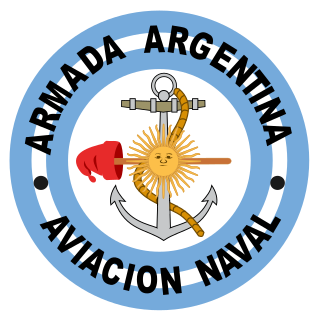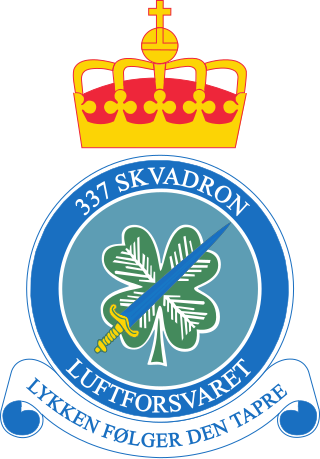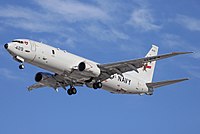
The German Navy is the navy of Germany and part of the unified Bundeswehr, the German Armed Forces. The German Navy was originally known as the Bundesmarine from 1956 to 1995, when Deutsche Marine became the official name with respect to the 1990 incorporation of the East German Volksmarine. It is deeply integrated into the NATO alliance. Its primary mission is protection of Germany's territorial waters and maritime infrastructure as well as sea lines of communication. Apart from this, the German Navy participates in peacekeeping operations, and renders humanitarian assistance and disaster relief. It also participates in anti-piracy operations.

The Sikorsky SH-60/MH-60 Seahawk is a twin turboshaft engine, multi-mission United States Navy helicopter based on the United States Army UH-60 Black Hawk and a member of the Sikorsky S-70 family. The most significant modifications are the folding main rotor blades and a hinged tail to reduce its footprint aboard ships.

A maritime patrol aircraft (MPA), also known as a patrol aircraft, maritime reconnaissance aircraft, maritime surveillance aircraft, or by the older American term patrol bomber, is a fixed-wing aircraft designed to operate for long durations over water in maritime patrol roles — in particular anti-submarine warfare (ASW), anti-ship warfare (AShW), and search and rescue (SAR).

The Westland WS-61 Sea King is a British licence-built version of the American Sikorsky S-61 helicopter of the same name, built by Westland Helicopters. The aircraft differs considerably from the American version, with Rolls-Royce Gnome engines, British-made anti-submarine warfare systems and a fully computerised flight control system. The Sea King was primarily designed for performing anti-submarine warfare (ASW) missions. A Sea King variant known as the Commando was developed by Westland to serve as a troop transport.

The Westland Lynx is a British multi-purpose twin-engined military helicopter designed and built by Westland Helicopters at its factory in Yeovil. Originally intended as a utility craft for both civil and naval usage, military interest led to the development of both battlefield and naval variants. The Lynx went into operational usage in 1977 and was later adopted by the armed forces of over a dozen nations, primarily serving in the battlefield utility, anti-armour, search and rescue and anti-submarine warfare roles.

The NHIndustries NH90 is a European medium-sized, twin-engine, multirole military helicopter. It was the first production helicopter to feature entirely fly-by-wire flight controls.

The Fairey Gannet is a carrier-borne aircraft that was designed and produced by the British aircraft manufacturer the Fairey Aviation Company. It was developed for the Royal Navy, being the first fixed-wing aircraft to combine both the search and strike portions of anti-submarine warfare (ASW) operations to be operated by the Fleet Air Arm (FAA).

Bardufoss Air Station is a military air station located at Bardufoss in Målselv Municipality in Troms county in Northern Norway. It is the location of the Royal Norwegian Air Force (RNoAF) 139 Air Wing and two helicopter squadrons; the 337 Squadron operating Lynx MK 86 for the Norwegian Coast Guard and the 339 Squadron equipped with Bell 412SPs. It is also the base for the RNoAF Flight Training School. In addition, helicopter Squadron no. 334 is currently under establishment as it will be operating NH90 NFH helicopters. The delivery of the NH90 helicopters just started. 334 Squadron will only have its command post and maintenance facilities at Bardufoss, as the helicopters will be stationed on the new Fridtjof Nansen class frigates when they arrive.

The Breguet Br.1150 Atlantic is a long-range maritime patrol aircraft designed and manufactured by French aircraft manufacturer Breguet Aviation.

French Naval Aviation is the naval air arm of the French Navy. The long-form official designation is Force maritime de l'aéronautique navale. Born as a fusion of aircraft carrier squadrons and the naval patrol air force, the Aéronavale was created in 1912. The force is under the command of a flag officer officially titled Admiral of Naval Aviation (ALAVIA) with his headquarters at Toulon naval base. It has a strength of around 6,800 military and civilian personnel. It operates from four airbases in Metropolitan France and several detachments in foreign countries or French overseas territories. Carrier-borne pilots of the French Navy do their initial training at Salon-de-Provence Air Base after which they undergo their carrier qualification with the US Navy.

The Portuguese Air Force is the aerial warfare force of Portugal. Locally it is referred to by the acronym FAP but internationally is often referred to by the acronym PRTAF. It is the youngest of the three branches of the Portuguese Armed Forces.
The Netherlands Naval Aviation Service is the naval aviation branch of the Royal Netherlands Navy.
Aeronauticum is the official German maritime aircraft museum – located in Nordholz. The museum has a large collection of aircraft that has been used by the German Marine/Navy, among other places also in the adjacent Nordholz Naval Airbase. The name of the museum derives from Greek ὰήρ āēr which means "air" and ναυτική nautikē which means "navigation, Airmanship", i.e. "navigation of the air".

Nordholz Naval Airbase is a German Naval Air base located near the town of Nordholz in Lower Saxony, 25 km north of Bremerhaven, and 12 km southwest of Cuxhaven. It is the home of Naval Air Command (Marinefliegerkommando), with Naval Air Wing 3 and Naval Air Wing 5, equipped with the P-3C Orion, Dornier 228NG, Mk88A Sea Lynx and Mk41 Sea King.

The Argentine Naval Aviation is the naval aviation branch of the Argentine Navy and one of its four operational commands. Argentina, along with Brazil is one of two South American countries to have operated two aircraft carriers.

The Pakistan Naval Air Arm is the naval aviation branch within the Pakistan Navy that is responsible for aerial operations from the seaborne platform.

The PNS Mehran is the naval station and the premier air–to-air/air–to–ground training naval air station located in the joint vicinity of the Faisal Air Force Base in Karachi, Sindh, in Pakistan. Established in 1975 with the cooperation of the Pakistan Air Force, the PNS Mehran serves in the capacity as the headquarter of the Naval Aviation Branch of the Pakistan Navy, and grown to its present inventory of 41 multi role aircraft. The latest addition in the Air Arm is the ATR-72.

INS Garuda, is an Indian naval air station located in Kochi, in the state of Kerala. Commissioned on 11 May 1953, it is the oldest operating air station of the Indian Navy.

The 337 Squadron is a maritime helicopter unit of the Royal Norwegian Air Force (RNoAF). Based at Bardufoss Air Station, the squadron most recently operated eight NHIndustries NH90 until June 2022. The helicopters were used by the Norwegian Coast Guard and served on the Nordkapp-class, the Barentshav-class and on NoCGV Svalbard.

860 Naval Air Squadron was a Naval Air Squadron of the Royal Navy's Fleet Air Arm during World War II, which was transferred to the Royal Netherlands Navy in 1946, and remains active.

































